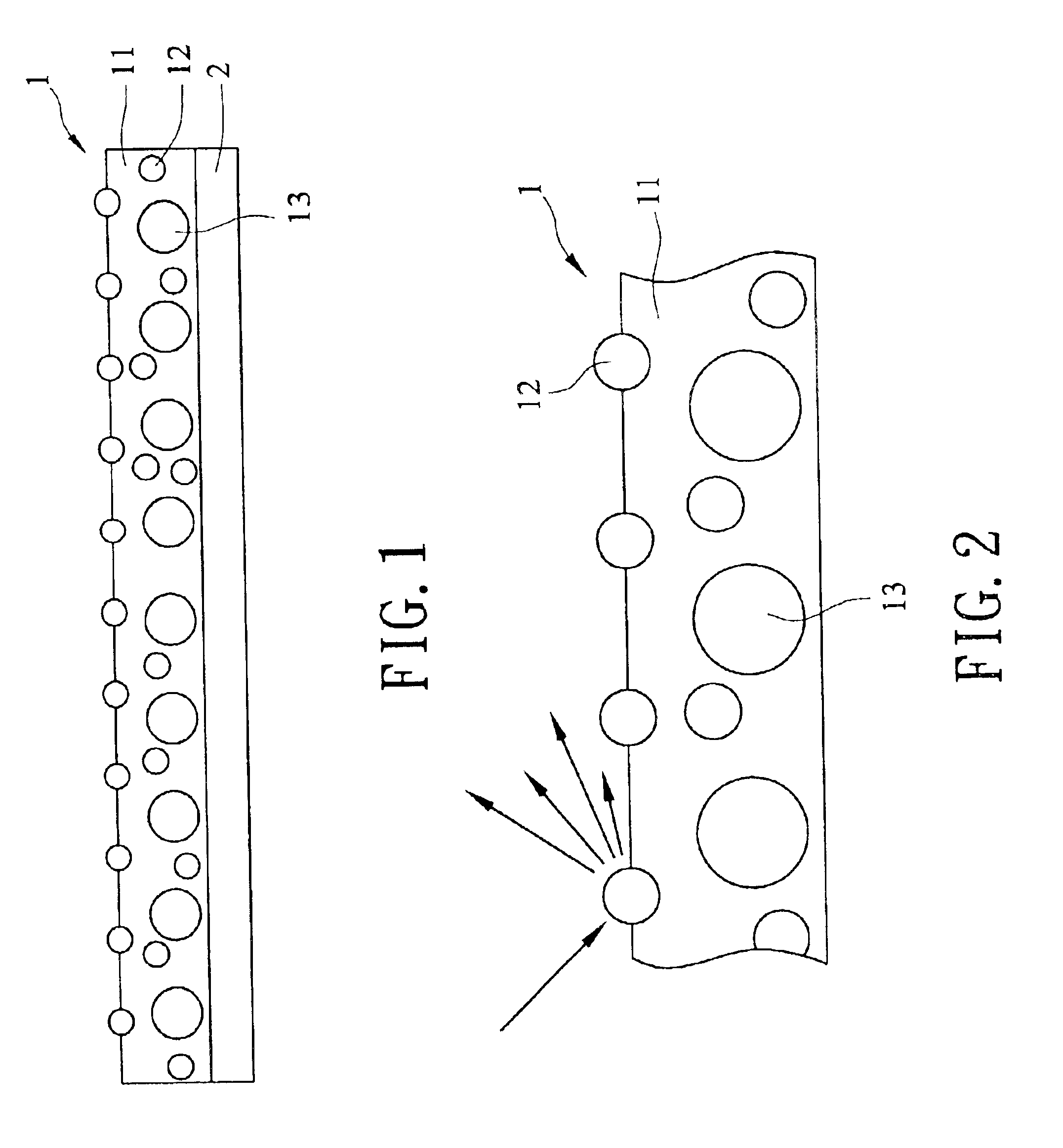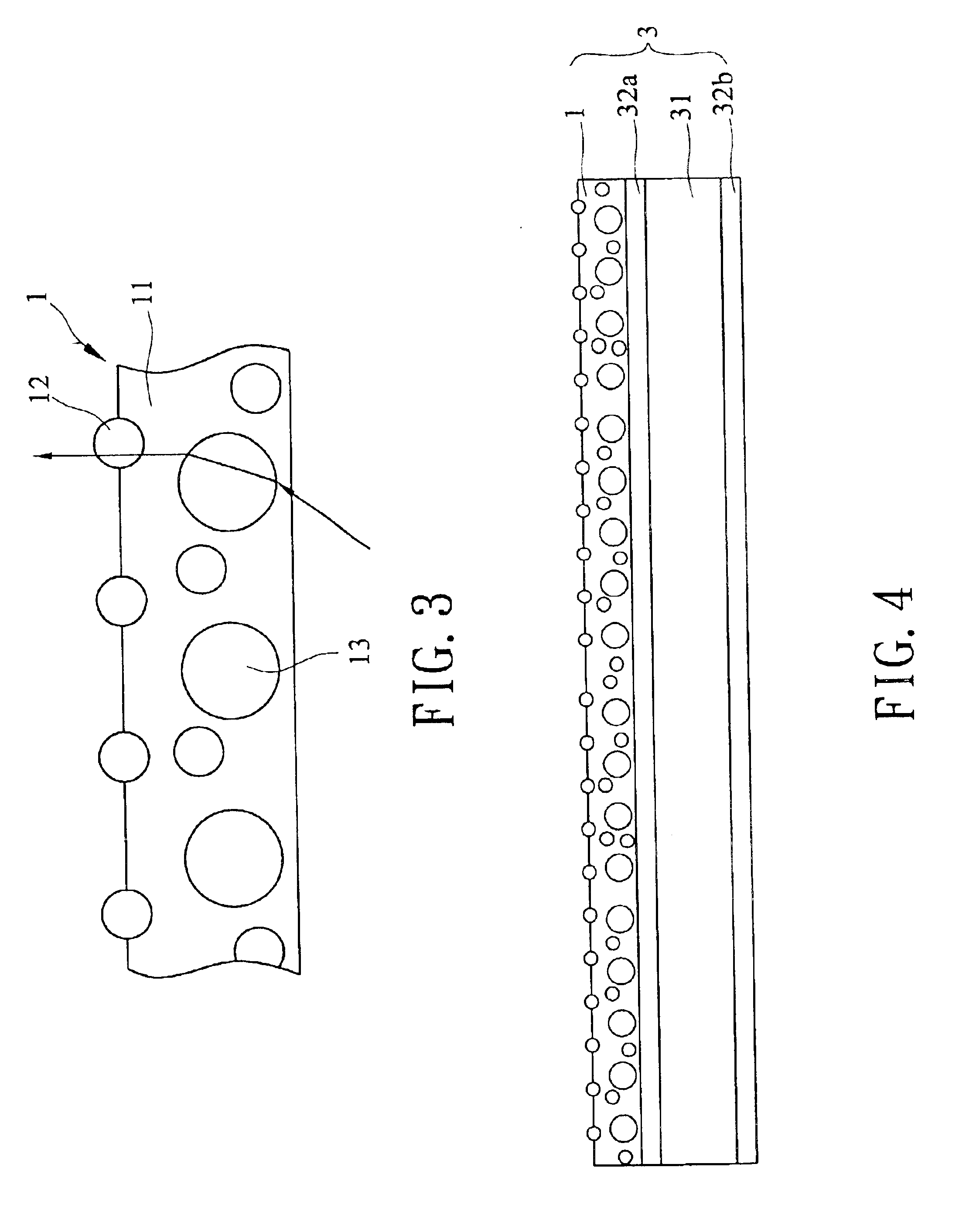Antiglare film
a film and antiglare technology, applied in the field of antiglare film, can solve the problems of insufficient film visibility, irritating user's eyes, and glare, and achieve the effects of increasing image clarity, different refractive index, and increasing visibility
- Summary
- Abstract
- Description
- Claims
- Application Information
AI Technical Summary
Benefits of technology
Problems solved by technology
Method used
Image
Examples
embodiment 1
Each with 20 parts by weight of two ultraviolet-curing resins CN983B88 of Sartomer Co. and KRM7039 of Daicel Co. that have a same refractive index of 1.45; 2 parts by weight of photo-cationic polymerization initiator (a product of Ciba Co., Irgacure 184); 10 parts by weight of nano-grade silica particles as the First particles (a product of Clariant Co., OG502-31, having refractive index 1.45 and average particle diameter 13 nanometers); and 4 parts by weight of polystyrene beads as the second particles (a product of Soken Co., having average diameter 3.5 micrometers and refractive index 1.57) were added. To the obtained mixture, 50 parts by weight of isopropyl alcohol was added and mixed well to prepare a hard coat material. Then, a film of triacetate (a product of Fuji Co, T-80UZ) was coated with the above hard coat material in a wet film thickness of 20 micrometers, and the obtained product was dried at 70° C. for 3 minute. The dried layer was irradiated with ultraviolet light us...
embodiment 2
Each with 20 parts by weight of two ultraviolet-curing resins CN983B88 of Sartomer Co. and KRM7039 of Daicel Co. that have a same refractive index of 1.45; 2 parts by weight of photo-cationic polymerization initiator (a product of Ciba Co., Irgacure 184); 10 parts by weight of nano-grade silica particles as the first particles (a product of Clariant Co., OG502-31, having refractive index 1.45 and average particle diameter 13 nanometers); and 2 parts by weight of polystyrene beads as the second particles (a product of Soken Co., having average diameter 3.5 micrometers and refractive index 1.57) were added. To the obtained mixture, 50 parts by weight of isopropyl alcohol was added and mixed well to prepare a hard coat material. Then, a film of triacetate (a product of Fuji Co, T-80UZ) was coated with the above hard coat material in a wet film thickness of 20 micrometers, and the obtained product was dried at 70° C. for 3 minute. The dried layer was irradiated with ultraviolet light us...
embodiment 3
Each with 20 parts by weight of two ultraviolet-curing resins CN983B88 of Sartomer Co. and KRM7039 of Daicel Co. that have a same refractive index of 1.45; 2 parts by weight of photo-cationic polymerization initiator (a product of Ciba Co., Irgacure 184); 10 parts by weight of nano-grade silica particles as the first particles (a product of Clariant Co., OG502-32, having refractive index 1.45 and average particle diameter 25 nanometers); and 4 parts by weight of polystyrene beads as the second particles (a product of Soken Co., having average diameter 3.5 micrometers and refractive index 1.57) were added. To the obtained mixture, 50 parts by weight of isopropyl alcohol was added and mixed well to prepare a hard coat material. Then, a film of triacetate (a product of Fuji Co, T-80UZ) was coated with the above hard coat material in a wet film thickness of 20 micrometers, and the obtained product was dried at 70° C. for 3 minute. The dried layer was irradiated with ultraviolet light us...
PUM
| Property | Measurement | Unit |
|---|---|---|
| Length | aaaaa | aaaaa |
| Diameter | aaaaa | aaaaa |
| Diameter | aaaaa | aaaaa |
Abstract
Description
Claims
Application Information
 Login to View More
Login to View More - R&D
- Intellectual Property
- Life Sciences
- Materials
- Tech Scout
- Unparalleled Data Quality
- Higher Quality Content
- 60% Fewer Hallucinations
Browse by: Latest US Patents, China's latest patents, Technical Efficacy Thesaurus, Application Domain, Technology Topic, Popular Technical Reports.
© 2025 PatSnap. All rights reserved.Legal|Privacy policy|Modern Slavery Act Transparency Statement|Sitemap|About US| Contact US: help@patsnap.com



